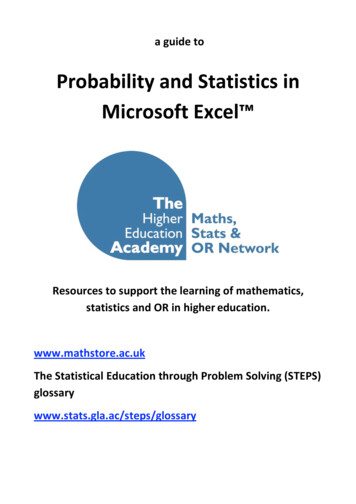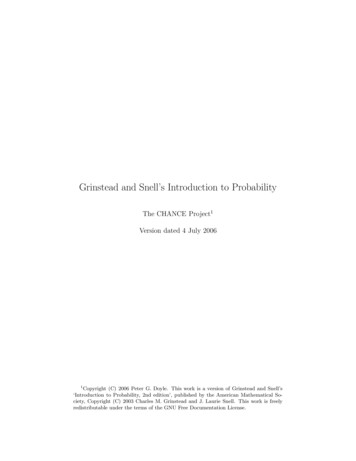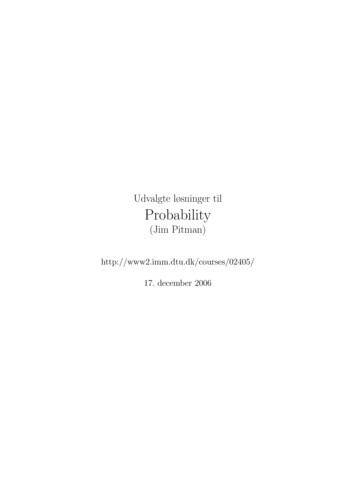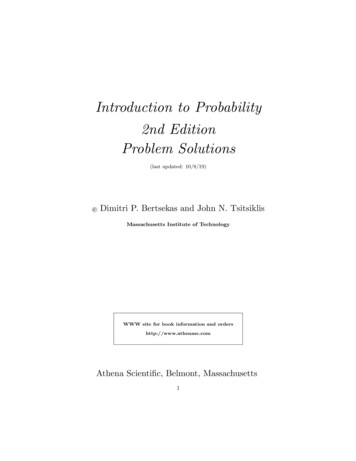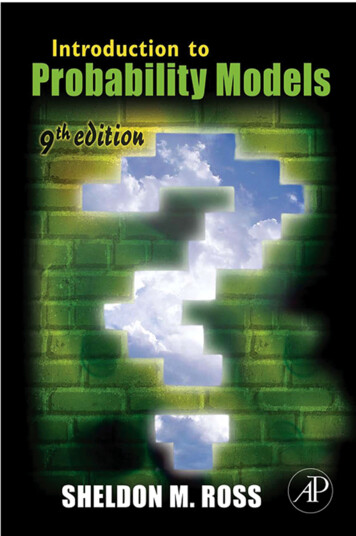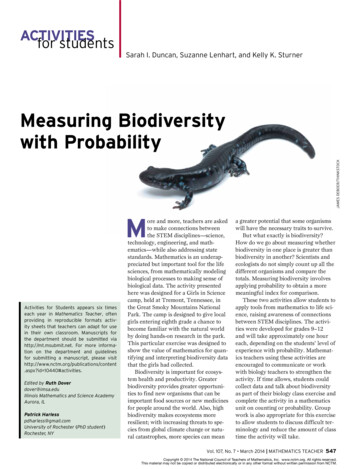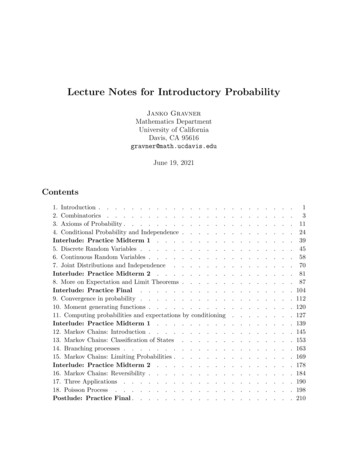
Transcription
Lecture Notes for Introductory ProbabilityJanko GravnerMathematics DepartmentUniversity of CaliforniaDavis, CA 95616gravner@math.ucdavis.eduJune 19, 2021Contents1. Introduction . . . . . . . . . . . . . . . .2. Combinatorics . . . . . . . . . . . . . . .3. Axioms of Probability . . . . . . . . . . . . .4. Conditional Probability and Independence . . . . . .Interlude: Practice Midterm 1 . . . . . . . . .5. Discrete Random Variables . . . . . . . . . . .6. Continuous Random Variables . . . . . . . . . .7. Joint Distributions and Independence . . . . . . .Interlude: Practice Midterm 2 . . . . . . . . .8. More on Expectation and Limit Theorems . . . . . .Interlude: Practice Final . . . . . . . . . . .9. Convergence in probability . . . . . . . . . . .10. Moment generating functions . . . . . . . . . .11. Computing probabilities and expectations by conditioningInterlude: Practice Midterm 1 . . . . . . . . .12. Markov Chains: Introduction . . . . . . . . . .13. Markov Chains: Classification of States . . . . . .14. Branching processes . . . . . . . . . . . . .15. Markov Chains: Limiting Probabilities . . . . . . .Interlude: Practice Midterm 2 . . . . . . . . .16. Markov Chains: Reversibility . . . . . . . . . .17. Three Applications . . . . . . . . . . . . .18. Poisson Process . . . . . . . . . . . . . .Postlude: Practice Final . . . . . . . . . . . 84190198210
ForewordThese notes were started in January 2009 with help from Christopher Ng, a student in Math135A and 135B classes at UC Davis, who typeset the notes he took during my lectures. Thistext is not a treatise in elementary probability and has no lofty goals; instead, its aim is tohelp a student achieve the proficiency in the subject required for a typical exam and basicreal-life applications. Therefore, its emphasis is on examples, which are chosen without muchredundancy. A reader should strive to understand every example given and be able to designand solve a similar one. Problems at the end of chapters and on sample exams (the solutionsto all of which are provided) have been selected from actual exams, hence should be used as atest for preparedness.I have only one tip for studying probability: you cannot do it half-heartedly. You have todevote to this class several hours per week of concentrated attention to understand the subjectenough so that standard problems become routine. If you think that coming to class and readingthe examples while also doing something else is enough, you’re in for an unpleasant surprise onthe exams.This text will always be available free of charge to UC Davis students. Please contact meif you spot any mistake. I am thankful to Marisano James and Kenneth Tam for numerouscorrections and helpful suggestions.Copyright 2010–2021, Janko Gravner
11INTRODUCTION1IntroductionThe theory of probability has always been associated with gambling and many most accessibleexamples still come from that activity. You should be familiar with the basic tools of thegambling trade: a coin, a (six-sided) die, and a full deck of 52 cards. A fair coin gives you Heads(H) or Tails (T) with equal probability, a fair die will give you 1, 2, 3, 4, 5, or 6 with equalprobability, and a shuffled deck of cards means that any ordering of cards is equally likely.Example 1.1. Here are typical questions that we will be asking and that you will learn how toanswer. This example serves as an illustration and you should not expect to understand how toget the answer yet.Start with a shuffled deck of cards and distribute all 52 cards to 4 players, 13 cards to each.What is the probability that each player gets an Ace? Next, assume that you are a player andyou get a single Ace. What is the probability now that each player gets an Ace?Answers. If any ordering of cards is equally likely, then any position of the four Aces in thedeck is also equally likely. There are 524 possibilities for the positions (slots) for the 4 aces. Outof these, the number of positions that give each player an Ace is 134 : pick the first slot amongthe cards that the first player gets, then the second slot among the second player’s cards, then4the third and the fourth slot. Therefore, the answer is 13 0.1055.(524)After you see that you have a single Ace, the probability goes up: the previous answer needs13·(39)to be divided by the probability that you get a single Ace, which is 523 0.4388. The answer(4)134then becomes 13· 39 0.2404.(3)Here is how you can quickly estimate the second probability during a card game: give thesecond ace to a player, the third to a different player (probability about 2/3) and then the lastto the third player (probability about 1/3) for the approximate answer 2/9 0.22.History of probabilityAlthough gambling dates back thousands of years, the birth of modern probability is consideredto be a 1654 letter from the Flemish aristocrat and notorious gambler Chevalier de Méré to themathematician and philosopher Blaise Pascal. In essence the letter said:I used to bet even money that I would get at least one 6 in four rolls of a fair die.The probability of this is 4 times the probability of getting a 6 in a single die, i.e.,4/6 2/3; clearly I had an advantage and indeed I was making money. Now I beteven money that within 24 rolls of two dice I get at least one double 6. This has thesame advantage (24/62 2/3), but now I am losing money. Why?As Pascal discussed in his correspondence with Pierre de Fermat, de Méré’s reasoning was faulty;after all, if the number of rolls were 7 in the first game, the logic would give the nonsensicalprobability 7/6. We’ll come back to this later.
1INTRODUCTION2Example 1.2. In a family with 4 children, what is the probability of a 2:2 boy-girl split?One common wrong answer:likely.15,as the 5 possibilities for the number of boys are not equallyAnother common guess: close to 1, as this is the most “balanced” possibility. This represents the mistaken belief that symmetry in probabilities should very likely result in symmetry inthe outcome. A related confusion supposes that events that are probable (say, have probabilityaround 0.75) occur nearly certainly.Equally likely outcomesSuppose an experiment is performed, with n possible outcomes comprising a set S. Assumealso that all outcomes are equally likely. (Whether this assumption is realistic depends on thecontext. The above Example 1.2 gives an instance where this is not a reasonable assumption.)An event E is a set of outcomes, i.e., E S. If an event E consists of m different outcomes(often called “good” outcomes for E), then the probability of E is given by:(1.1)P (E) m.nExample 1.3. A fair die has 6 outcomes; take E {2, 4, 6}. Then P (E) 12 .What does the answer in Example 1.3 mean? Every student of probability should spendsome time thinking about this. The fact is that it is very difficult to attach a meaning to P (E)if we roll a die a single time or a few times. The most straightforward interpretation is that fora very large number of rolls about half of the outcomes will be even. Note that this requiresat least the concept of a limit! This relative frequency interpretation of probability will beexplained in detail much later. For now, take formula (1.1) as the definition of probability.
22COMBINATORICS3CombinatoricsExample 2.1. Toss three fair coins. What is the probability of exactly one Heads (H)?There are 8 equally likely outcomes: HHH, HHT, HTH, HTT, THH, THT, TTH, TTT. Outof these, 3 have exactly one H. That is, E {HTT, THT, TTH}, and P (E) 3/8.Example 2.2. Let us now compute the probability of a 2:2 boy-girl split in a four-childrenfamily. We have 16 outcomes, which we will assume are equally likely, although this is not quitetrue in reality. We list the outcomes below, although we will soon see that there is a better way.BBBBBGBBGBBBGGBBBBBGBGBGGBBGGGBGWe conclude thatP (2:2 split) BBGBBGGBGBGBGGGBBBGGBGGGGBGGGGGG36 ,16881 ,16221P (4:0 split or 0:4 split) .168P (1:3 split or 3:1 split) Example 2.3. Roll two dice. What is the most likely sum?Outcomes are ordered pairs (i, j), 1 i 6, 1 j 6.sum23456789101112Our answer is 7, and P (sum 7) 636no. of outcomes12345654321 61 .
2COMBINATORICS4How to count?Listing all outcomes is very inefficient, especially if their number is large. We will, therefore,learn a few counting techniques, starting with a trivial, but conceptually important fact.Basic principle of counting. If an experiment consists of two stages and the first stage hasm outcomes, while the second stage has n outcomes regardless of the outcome at the firststage, then the experiment as a whole has mn outcomes.Example 2.4. Roll a die 4 times. What is the probability that you get different numbers?At least at the beginning, you should divide every solution into the following three steps:Step 1: Identify the set of equally likely outcomes. In this case, this is the set of all ordered4-tuples of numbers 1, . . . , 6. That is, {(a, b, c, d) : a, b, c, d {1, . . . , 6}}.Step 2: Compute the number of outcomes. In this case, it is therefore 64 .Step 3: Compute the number of good outcomes. In this case it is 6 · 5 · 4 · 3. Why? Wehave 6 options for the first roll, 5 options for the second roll since its number must differfrom the number on the first roll; 4 options for the third roll since its number must notappear on the first two rolls, etc. Note that the set of possible outcomes changes fromstage to stage (roll to roll in this case), but their number does not!The answer then is6·5·4·364 518 0.2778.Example 2.5. Let us now compute probabilities for de Méré’s games.In Game 1, there are 4 rolls and he wins with at least one 6. The number of good outcomesis 54 , as the number of bad outcomes is 54 . Therefore 45P (win) 1 0.5177.664In Game 2, there are 24 rolls of two dice and he wins by at least one pair of 6’s rolled. Thenumber of outcomes is 3624 , the number of bad ones is 3524 , thus the number of good outcomesequals 3624 3524 . Therefore 2435 0.4914.P (win) 1 36Chevalier de Méré overcounted the good outcomes in both cases. His count 4 · 63 in Game1 selects a die with a 6 and arbitrary numbers for other dice. However, many outcomes havemore than one six and are hence counted more than once.One should also note that both probabilities are barely different from 1/2, so de Méré wasgambling a lot to be able to notice the difference.
2COMBINATORICS5PermutationsAssume you have n objects. The number of ways to fill n ordered slots with them isn · (n 1) . . . 2 · 1 n!,while the number of ways to fill k n ordered slots isn(n 1) . . . (n k 1) n!.(n k)!Example 2.6. Shuffle a deck of cards. P (top card is an Ace) 113 4·51!52! . P (all cards of the same suit end up next to each other) never happens in practice. P (hearts are together) 40!13!52!4!·(13!)452! 4.5·10 28 . This event 6 · 10 11 .To compute the last probability, for example, collect all hearts into a block; a good outcomeis specified by ordering 40 items (the block of hearts plus 39 other cards) and ordering the heartswithin their block.Before we go on to further examples, let us agree that when the text says without furtherelaboration, that a random choice is made, this means that all available choices are equallylikely. Also, in the next problem (and in statistics in general) sampling with replacement refersto choosing, at random, an object from a population, noting its properties, putting the objectback into the population, and then repeating. Sampling without replacement omits the puttingback part.Example 2.7. A bag has 6 pieces of paper, each with one of the letters, E, E, P , P , P , andR, on it. Pull 6 pieces at random out of the bag (1) without, and (2) with replacement. Whatis the probability that these pieces, in order, spell P EP P ER?There are two problems to solve. For sampling without replacement:1. An outcome is an ordering of the pieces of paper E1 E2 P1 P2 P3 R.2. The number of outcomes thus is 6!.3. The number of good outcomes is 3!2!.The probability is3!2!6! 160 .For sampling with replacement, the answer is33 ·2266 1,2·63quite a lot smaller.
2COMBINATORICS6Example 2.8. Sit 3 men and 3 women at random (1) in a row of chairs and (2) around a table.Compute P (all women sit together). In case (2), also compute P (men and women alternate).In case (1), the answer is4!3!6! 15 .For case (2), pick a man, say John Smith, and sit him first. Then, we reduce to a row3problem with 5! outcomes; the number of good outcomes is 3! · 3!. The answer is 10. For thelast question, the seats for the men and women are fixed after John Smith takes his seat and so1the answer is 3!2!5! 10 .Example 2.9. A group consists of 3 Norwegians, 4 Swedes, and 5 Finns, and they sit at randomaround a table. What is the probability that all groups end up sitting together?The answer is 3!·4!·5!·2! 0.000866. Pick, say, a Norwegian (Arne) and sit him down. Here is11!how you count the good outcomes. There are 3! choices for ordering the group of Norwegians(and then sit them down to one or both sides of Arne, depending on the ordering). Then, thereare 4! choices for arranging the Swedes and 5! choices for arranging the Finns. Finally, there are2! choices to order the two blocks of Swedes and Finns.CombinationsLetnk be the number of different subsets with k elements of a set with n elements. Then, n(n 1) . . . (n k 1)n kk!n! k!(n k)!To understand why the above is true, first choose a subset, then order its elements in a rowto fill k ordered slots with elements from the set with n objects. Then, distinct choices of asubset and its ordering will end up as distinct orderings. Therefore, nk! n(n 1) . . . (n k 1).k We call nk P n choosek or a binomial coefficient (as it appears in the binomial theorem: (x y)n nk 0 nk xk y n k ). Also, note that nnnn 1 and .0nkn kThe multinomial coefficients are more general and are defined next.
2COMBINATORICS7The number of ways to divide a set of n elements into r (distinguishable)subsets of nandn1 , n2 , . . . , nr elements, where n1 . . . nr n, is denoted by n1 .nr nn1 . . . nr n n1n2n!n1 !n2 ! . . . nr !nn1 n n1 . . . nr 1n n1 n2.nrn3To understand the slightly confusing word distinguishable, just think of painting n1 elementsred, then n2 different elements blue, etc. These colors distinguish among the different subsets.Example 2.10. A fair coin is tossed 10 times. What is the probability that we get exactly 5Heads? 105 0.2461,210as one needs to choose the position of the five heads among 10 slots to fix a good outcome.P (exactly 5 Heads) Example 2.11. We have a bag that contains 100 balls, 50 of them red and 50 blue. Select 5balls at random. What is the probability that 3 are blue and 2 are red? and all of them are equally likely, which is a reasonableThe number of outcomes is 1005interpretation of “select 5 balls at random.” The answer is 50 50P (3 are blue and 2 are red) 3 21005 0.3189Why should this probability be less than a half? The probability that 3 are blue and 2 arered is equal to the probability of 3 are red and 2 are blue and they cannot both exceed 12 , astheir sum cannot be more than 1. It cannot be exactly 12 either, because other possibilities (suchas all 5 chosen balls red) have probability greater than 0.Example 2.12. Here we return to Example 1.1 and solve it more slowly. Shuffle a standarddeck of 52 cards and deal 13 cards to each of the 4 players.What is the probability that each player gets an Ace? We will solve this problem in twoways to emphasize that you often have a choice in your set of equally likely outcomes.The first way uses an outcome to be an ordering of 52 cards:1. There are 52! equally likely outcomes.2. Let the first 13 cards go to the first player, the second 13 cards to the second player,etc. Pick a slot within each of the four segments of 13 slots for an Ace. There are 134possibilities to choose these four slots for the Aces.3. The number of choices to fill these four positions with (four different) Aces is 4!.4. Order the rest of the cards in 48! ways.
2COMBINATORICSThe probability, then, is8134 4!48!52! .The second way, via a small leap of faith, assumes that each set of the four positions of thefour Aces among the 52 shuffled cards is equally likely. You may choose to believe this intuitivefact or try to write down a formal proof: the number of permutations that result in a given setF of four positions is independent of F . Then:1. The outcomes are the positions of the 4 Aces among the 52 slots for the shuffled cards ofthe deck. 2. The number of outcomes is 524 .3. The number of good outcomes is 134 , as we need to choose one slot among 13 cards thatgo to the first player, etc.The probability, then, is134(524), which agrees with the number we obtained the first way.Let us also compute P (one person has all four Aces). Doing the problem the second way,we get1. The number of outcomes is524 .2. To fix a good outcome, pick one player ( that player ( 134 choices).The answer, then, is41 choices) and pick four slots for the Aces for(41)(134) 0.0106, a lot smaller than the probability of each player getting)(524an Ace.Example 2.13. Roll a die 12 times. P (each number appears exactly twice)?1. An outcome consists of filling each of the 12 slots (for the 12 rolls) with an integer between1 and 6 (the outcome of the roll).2. The number of outcomes, therefore, is 612 .3. To fix a good outcome, pick two slots for 1, then pick two slots for 2, etc., withchoices.The probability, then, is10. 2(122 )( 2 ) (2)612122 102 .22 .What is P (1 appears exactly 3 times, 2 appears exactly 2 times)?To fix a good outcome now, pick three slots for 1, two slots for 2, and fill the remaining 79 7 9 74(123 )(2)slots by numbers 3, . . . , 6. The number of choices is 12.32 4 and the answer is612Example 2.14. We have 14 rooms and 4 colors, white, blue, green, and yellow. Each room ispainted at random with one of the four colors. There are 414 equally likely outcomes, so, for
2COMBINATORICS9example, 9 5 2 P (5 white, 4 blue, 3 green, 2 yellow rooms) 145441432.Example 2.15. A middle row on a plane seats 7 people. Three of them order chicken (C) andthe remaining four pasta (P). The flight attendant returns with the meals, but has forgottenwho ordered what and discovers that they are all asleep, so she puts the meals in front of themat random. What is the probability that they all receive correct meals?A reformulation makes the problem clearer: we are interested in P (3 people who ordered Cget C). Let us label the people 1, . . . , 7 and assume that 1, 2, and 3 ordered C. The outcomeis a selection of 3 people from the 7 who receive C, the number of them is 73 , and there is a1single good outcome. So, the answer is 17 35. Similarly,( 3) 443P (no one who ordered C gets C) 7 ,353 3 · 4218P (a single person who ordered C gets C) 7 ,353 3·412P (two persons who ordered C get C) 2 7 .353Problems1. A California licence plate consists of a sequence of seven symbols: number, letter, letter,letter, number, number, number, where a letter is any one of 26 letters and a number is oneamong 0, 1, . . . , 9. Assume that all licence plates are equally likely. (a) What is the probabilitythat all symbols are different? (b) What is the probability that all symbols are different and thefirst number is the largest among the numbers?2. A tennis tournament has 2n participants, n Swedes and n Norwegians. First, n people arechosen at random from the 2n (with no regard to nationality) and then paired randomly withthe other n people. Each pair proceeds to play one match. An outcome is a set of n (ordered)pairs, giving the winner and the loser in each of the n matches. (a) Determine the number ofoutcomes. (b) What do you need to assume to conclude that all outcomes are equally likely?(c) Under this assumption, compute the probability that all Swedes are the winners.3. A group of 18 Scandinavians consists of 5 Norwegians, 6 Swedes, and 7 Finns. They are seatedat random around a table. Compute the following probabilities: (a) that all the Norwegianssit together, (b) that all the Norwegians and all the Swedes sit together, and (c) that all theNorwegians, all the Swedes, and all the Finns sit together.
2COMBINATORICS104. A bag contains 80 balls numbered 1, . . . , 80. Before the game starts, you choose 10 differentnumbers from amongst 1, . . . , 80 and write them on a piece of paper. Then 20 balls are selected(without replacement) out of the bag at random. (a) What is the probability that all yournumbers are selected? (b) What is the probability that none of your numbers is selected? (c)What is the probability that exactly 4 of your numbers are selected?5. A full deck of 52 cards contains 13 hearts. Pick 8 cards from the deck at random (a) withoutreplacement and (b) with replacement. In each case compute the probability that you get nohearts.Solutions to problems1. (a)10·9·8·7·26·25·24,104 ·263(b) the answer in (a) times 41 . 2. (a) Divide into two groups (winners and losers), then pair them: 2nn · n!. Alternatively, pairthe first player, then the next available player, etc., and, then, at the end choose the winnersand the losers: (2n 1)(2n 3) · · · 3 · 1 · 2n . (Of course, these two expressions are the same.)(b) All players are of equal strength, equally likely to win or lose any match against any otherplayer. (c) The number of good outcomes is n!, the choice of a Norwegian paired with eachSwede.3. (a)13!·5!17! ,4. (a)70(70(10(7010)20)4 )(16).80 , (b)80 , (c)80(20)(20)(20)5. (a)(398), (b)(528)(b)8!·5!·6!17! , 3 84 .(c)2!·7!·6!·5!.17!
33AXIOMS OF PROBABILITY11Axioms of ProbabilityThe question here is: how can we mathematically define a random experiment? What we haveare outcomes (which tell you exactly what happens), events (sets containing certain outcomes),and probability (which attaches to every event the likelihood that it happens). We need toagree on which properties these objects must have in order to compute with them and developa theory.When we have finitely many equally likely outcomes all is clear and we have already seenmany examples. However, as is common in mathematics, infinite sets are much harder to dealwith. For example, we will soon see what it means to choose a random point within a unit circle.On the other hand, we will also see that there is no way to choose at random a positive integer— remember that “at random” means all choices are equally likely, unless otherwise specified.Finally, a probability space is a triple (Ω, F, P ). The first object Ω is an arbitrary set,representing the set of outcomes, sometimes called the sample space.The second object F is a collection of events, that is, a set of subsets of Ω. Therefore, anevent A F is necessarily a subset of Ω. Can we just say that each A Ω is an event? In thiscourse you can assume so without worry, although there are good reasons for not assuming soin general ! I will give the definition of what properties F needs to satisfy, but this is only forillustration and you should take a course in measure theory to understand what is really goingon. Namely, F needs to be a σ-algebra, which means (1) F, (2) A F Ac F, and(3) A1 , A2 , · · · F i 1 Ai F.What is important is that you can take the complement Ac of an event A (i.e., Ac happenswhen A does not happen), unions of two or more events (i.e., A1 A2 happens when either A1or A2 happens), and intersections of two or more events (i.e., A1 A2 happens when both A1and A2 happen). We call events A1 , A2 , . . . pairwise disjoint if Ai Aj if i 6 j — that is,at most one of these events can occur.Finally, the probability P is a number attached to every event A and satisfies the followingthree axioms:Axiom 1. For every event A, P (A) 0.Axiom 2. P (Ω) 1.Axiom 3. If A1 , A2 , . . . is a sequence of pairwise disjoint events, thenP( [i 1Ai ) XP (Ai ).i 1Whenever we have an abstract definition such as this one, the first thing to do is to look forexamples. Here are some.Example 3.1. Ω {1, 2, 3, 4, 5, 6},P (A) (number of elements in A).6
3AXIOMS OF PROBABILITY12The random experiment here is rolling a fair die. Clearly, this can be generalized to any finiteset with equally likely outcomes.Example 3.2. Ω {1, 2, . . .} and you have numbers p1 , p2 , . . . 0 with p1 p2 . . . 1. Forany A Ω,XP (A) pi .i AFor example, toss a fair coin repeatedly until the first Heads. Your outcome is the number oftosses. Here, pi 21i .Note that pi cannot be chosen to be equal, as you cannot make the sum of infinitely manyequal numbers to be 1.Example 3.3. Pick a point from inside the unit circle centered at the origin. Here, Ω {(x, y) :x2 y 2 1} and(area of A)P (A) .πIt is important to observe that if A is a singleton (a set whose element is a single point), thenP (A) 0. This means that we cannot attach the probability to outcomes — you hit a singlepoint (or even a line) with probability 0, but a “fatter” set with positive area you hit withpositive probability.Another important theoretical remark: this is a case where A cannot be an arbitrary subsetof the circle — for some sets area cannot be defined!Consequences of the axioms(C0) P ( ) 0.Proof . In Axiom 3, take all sets to be .(C1) If A1 A2 , then P (A1 A2 ) P (A1 ) P (A2 ).Proof . In Axiom 3, take all sets other than first two to be .(C2)P (Ac ) 1 P (A).Proof . Apply (C1) to A1 A, A2 Ac .
3AXIOMS OF PROBABILITY13(C3) 0 P (A) 1.Proof . Use that P (Ac ) 0 in (C2).(C4) If A B, P (B) P (A) P (B \ A) P (A).Proof . Use (C1) for A1 A and A2 B \ A.(C5) P (A B) P (A) P (B) P (A B).Proof . Let P (A \ B) p1 , P (A B) p12 and P (B \ A) p2 , and note that A \ B, A B, andB \A are pairwise disjoint. Then P (A) p1 p12 , P (B) p2 p12 , and P (A B) p1 p2 p12 .(C6)P (A1 A2 A3 ) P (A1 ) P (A2 ) P (A3 ) P (A1 A2 ) P (A1 A3 ) P (A2 A3 ) P (A1 A2 A3 )and more generallyP (A1 · · · An ) nXi 1P (Ai ) XP (Ai Aj ) 1 i j nXP (Ai Aj Ak ) . . .1 i j k n ( 1)n 1 P (A1 · · · An ).This is called the inclusion-exclusion formula and is commonly used when it is easier to computeprobabilities of intersections than of unions.Proof . We prove this only for n 3. Let p1 P (A1 Ac2 Ac3 ), p2 P (Ac1 A2 Ac3 ),p3 P (Ac1 Ac2 A3 ), p12 P (A1 A2 Ac3 ), p13 P (A1 Ac2 A3 ), p23 P (Ac1 A2 A3 ),and p123 P (A1 A2 A3 ). Again, note that all sets are pairwise disjoint and that the righthand side of (C6) is(p1 p12 p13 p123 ) (p2 p12 p23 p123 ) (p3 p13 p23 p123 ) (p12 p123 ) (p13 p123 ) (p23 p123 ) p123 p1 p2 p3 p12 p13 p23 p123 P (A1 A2 A3 ).
3AXIOMS OF PROBABILITY14Example 3.4. Pick an integer in [1, 1000] at random. Compute the probability that it isdivisible neither by 12 nor by 15.The sample space consists of the 1000 integers between 1 and 1000 and let Ar be the subsetconsisting of integers divisible by r. The cardinality of Ar is b1000/rc. Another simple factis that Ar As Alcm(r,s) , where lcm stands for the least common multiple. Our probabilityequals1 P (A12 A15 ) 1 P (A12 ) P (A15 ) P (A12 A15 ) 1 P (A12 ) P (A15 ) P (A60 )836616 1 0.867.1000 1000 1000Example 3.5. Sit 3 men and 4 women at random in a row. What is the probability that eitherall the men or all the women end up sitting together?Here, A1 {all women sit together}, A2 {all men sit together}, A1 A2 {both womenand men sit together}, and so the answer isP (A1 A2 ) P (A1 ) P (A2 ) P (A1 A2 ) 4! · 4! 5! · 3! 2! · 3! · 4! .7!7!7!Example 3.6. A group of 3 Norwegians, 4 Swedes, and 5 Finns is seated at random around atable. Compute the probability that at least one of the three groups ends up sitting together.Define AN {Norwegians sit together} and similarly AS , AF . We have3! · 9!4! · 8!5! · 7!, P (AS ) , P (AF ) ,11!11!11!3! · 5! · 5!4! · 5! · 4!3! · 4! · 6!, P (AN AF ) , P (AS AF ) ,P (AN AS ) 11!11!11!3! · 4! · 5! · 2!P (AN AS AF ) .11!P (AN ) Therefore,P (AN AS AF ) 3! · 9! 4! · 8! 5! · 7! 3! · 4! · 6! 3! · 5! · 5! 4! · 5! · 4! 3! · 4! · 5! · 2!.11!Example 3.7. Matching problem. A large company with n employees has a scheme accordingto which each employee buys a Christmas gift and the gifts are then distributed at random tothe employees. What is the probability that someone gets his or her own gift?Note that this is different from asking, assuming that you are one of the employees, for theprobability that you get your own gift, which is n1 .Let Ai {ith employee gets his or her own gift}. Then, what we are looking for isP(n[i 1Ai ).
3AXIOMS OF PROBABILITY15We haveP (Ai ) P (Ai Aj ) P (Ai Aj Ak ) .P (A1 · · · An ) 1(for all i),n(n 2)!1 (for all i j),n!n(n 1)(n 3)!1 (for all i j k),n!n(n 1)(n 2)1.n!Therefore, our answer is 11n1n1 . . . ( 1)n 1··nn(n 1)n(n 1)(n 2)n!23111 1 . . . ( 1)n 12! 3!n!1 1 0.6321 (as n ).en·Example 3.8. Birthday Problem. Assume that there are k people in the room. What isthe probability that there are two who share a birthday? We will ignore leap years, assumeall birthdays are equally likely, and generalize the problem a little: from n possible birthdays,sample k times with replacement.P (a shared birthday) 1 P (no shared birthdays) 1 n · (n 1) · · · (n k 1).nkWhen n 365, the lowest k for which the above exceeds 0.5 is, famously, k 23. Some valuesare given in the following tabl
1 selects a die with a 6 and arbitrary numbers for other dice. However, many outcomes have more than one six and are hence counted more than once. One should also note that both probabilities ar


